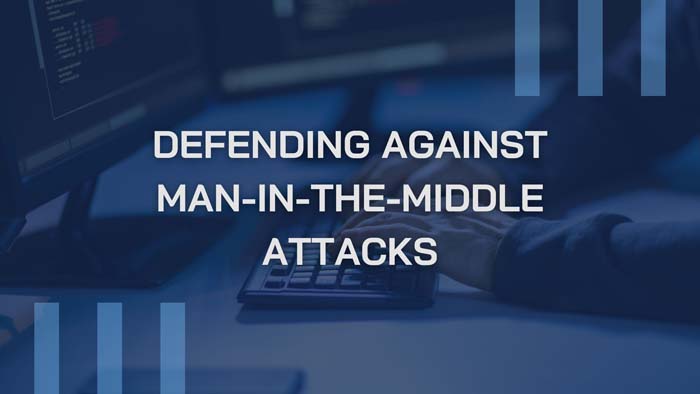In our hyper-connected digital age, where every click and keystroke can have profound implications, the specter of cyber threats, particularly the stealthy Man-in-the-Middle (MITM) attacks, haunts both individuals and corporations alike. A MITM attack, a form of cyber assault, operates in the shadows, intercepting communications between two parties by posing as a trusted intermediary. Understanding the intricacies of these attacks and adopting effective countermeasures is essential to fortify our defenses against this grave digital menace.
Unraveling the Complexity of Man-in-the-Middle Attacks:
The essence of a Man-in-the-Middle attack lies in its ability to operate surreptitiously. Attackers, often armed with advanced tools, secretly intercept and potentially modify data exchanged between users and websites. This interception in MITM occurs without the knowledge of the communicating parties, enabling attackers to eavesdrop on sensitive conversations, gather personal information, and manipulate data transmissions. Their primary targets are login credentials, credit card numbers, and other private data, rendering MITM attacks a significant concern for online security.
Techniques Employed in Man-in-the-Middle Attacks
MITM attacks manifest through various techniques meant to remain undetected, including:
1. Rogue Wi-Fi Access Points:
Attackers create counterfeit Wi-Fi networks, enticing unsuspecting users to connect. Once connected, the attacker gains unauthorized access to their data transmissions, making public Wi-Fi networks potential minefields of vulnerability.
2. DNS Spoofing:
In DNS Spoofing, attackers manipulate the Domain Name System to redirect users to malicious websites. Once users are lured to these sites, their sensitive information becomes ripe for the picking.
3. Session Hijacking:
By pilfering session cookies, attackers can impersonate users without needing their login credentials. This technique poses a significant threat to online sessions, allowing attackers to exploit active user sessions seamlessly.
Fortifying Your Digital Fortress: Proactive Measures Against MITM Attacks
1. Implementing HTTPS Encryption:
The bedrock of MITM attack prevention lies in implementing HTTPS encryption. This technology ensures that data exchanged between websites and users is encrypted, rendering it indecipherable to prying eyes during transmission. Users can identify secure websites by the padlock icon in the address bar, signifying a safe and encrypted connection.
2. Embracing Multi-Factor Authentication (MFA):
Multi-factor authentication (MFA) acts as an extra layer of security against MITM. It requires users to verify their identity through multiple methods, such as biometric scans, security tokens, or one-time codes. By adding this additional barrier, the effectiveness of stolen credentials is drastically reduced.
3. Deploying Web Application Firewalls (WAFs):
Web Application Firewalls (WAFs) act as vigilant sentinels, identifying and blocking malicious traffic before it reaches web applications against MITM. Properly configured WAFs can effectively thwart MITM attempts, preventing attackers from breaching web application defenses.
4. Regular Software Updates:
Frequent software updates are not mere inconveniences; they are shields against evolving cyber threats like MITM. Vendors release security patches that address vulnerabilities, thereby preventing potential exploitation by attackers. Ensuring that all software and applications are up-to-date is a fundamental step in safeguarding against MITM attacks.
Strengthening Your Digital Defenses: A Holistic Approach
In the face of Man-in-the-Middle attacks, a comprehensive and proactive strategy is paramount. Knowledge, vigilance, and the integration of advanced security technologies form the cornerstone of effective defense:
1. User Education and Awareness:
Empowering users with knowledge is a formidable weapon against MITM attacks. Educating individuals about the risks associated with unsecured Wi-Fi networks, the significance of secure browsing habits, and the telltale signs of phishing attempts equips them to identify potential threats and take informed action.
2. Collaborative Efforts:
Cybersecurity is a collective endeavor that transcends individual efforts. Collaboration between individuals, businesses, governments, and cybersecurity experts fosters the sharing of threat intelligence and best practices. These alliances create a fortified defense against the ever-evolving landscape of cyber threats.
3. Continuous Innovation:
In the ceaseless arms race between cybersecurity professionals and cybercriminals, innovation is key. Investment in research and development leads to the creation of advanced security technologies and strategies, ensuring that our defenses evolve alongside emerging threats.
Building A Secure Digital Future
In the relentless pursuit of a secure digital future, understanding the nuances of Man-in-the-Middle attacks and adopting proactive defense measures are non-negotiable. By arming ourselves with knowledge, leveraging advanced encryption technologies, embracing multi-factor authentication, and fostering collaborative efforts, we can navigate the digital landscape with confidence. Together, we can build an impregnable fortress, ensuring that our sensitive data and online transactions remain beyond the reach of Man-in-the-Middle attackers. Stay secure, stay vigilant, and safeguard your digital presence.

